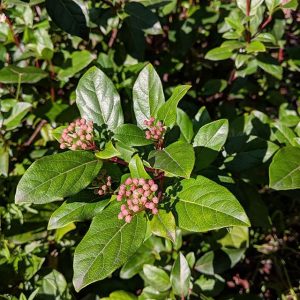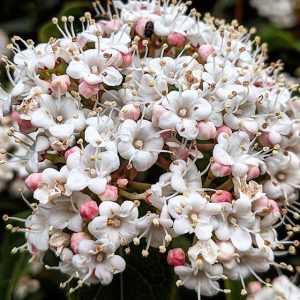Laurestinus/Laurustinus (Viburnum tinus) growing as a novel component in the damaged understoreys of Yarra Bend.
Laurustinus was a core component of the Victorian garden toolkit, a shiny evergreen shrub with bright corymbs of winter-spring flowers and a tolerance for hot, dry and shaded conditions. ‘A shrub of many virtues, too often relegated to dark corners.’ It shows up in all the early nursery catalogues for Melbourne, along with ‘Lucidum’, a brighter, showier cultivar.
The Australasian wrote at the end of the 1870s that ‘Lucidum is both for its flowers and its foliage a most desirable variety; no garden should be without it.’ Similarly, the Sydney Mail (1890): ‘Perhaps no plant makes a better lawn decorative object than the well-known Laurustinus, generally known as Viburnum tinus… it will make fine growth, and flower more or less the season through.’ And the Melbourne Leader (1915): ‘Laurustinus should need no description; it is one of the hardiest and best shrubs we have.’
Later, the plants would take on the presence of a nostalgia memory. The Sydney Sun-Herald asked in 1954 ‘who hasn’t seen the old but valiant ‘Laurustinus’ battling along in a hot, dry and windy spot? From coastline to inland, including the tablelands, filling a corner with foliage, and brightening winter days with pearly pink to white blossom clusters.’
The first recorded collection of Laurustinus in naturalised circumstances in Australia was as a roadside weed in the Adelaide Hills in 1957. The plant was also collected in Victoria soon after this, in 1964 off the back of an old property at Corinella on the east side of Westernport. It has been reported consistently in the Melbourne metropolitan since the 1980s, in the Yarra and its tributaries, down the front edge of the Dandenongs, and around the back outskirts of Frankston.
View Original Post on Instagram
Search for information about Viburnum tinus in the Flora of Victoria
View information and occurrences of Viburnum tinus on the Atlas of Living Australia











